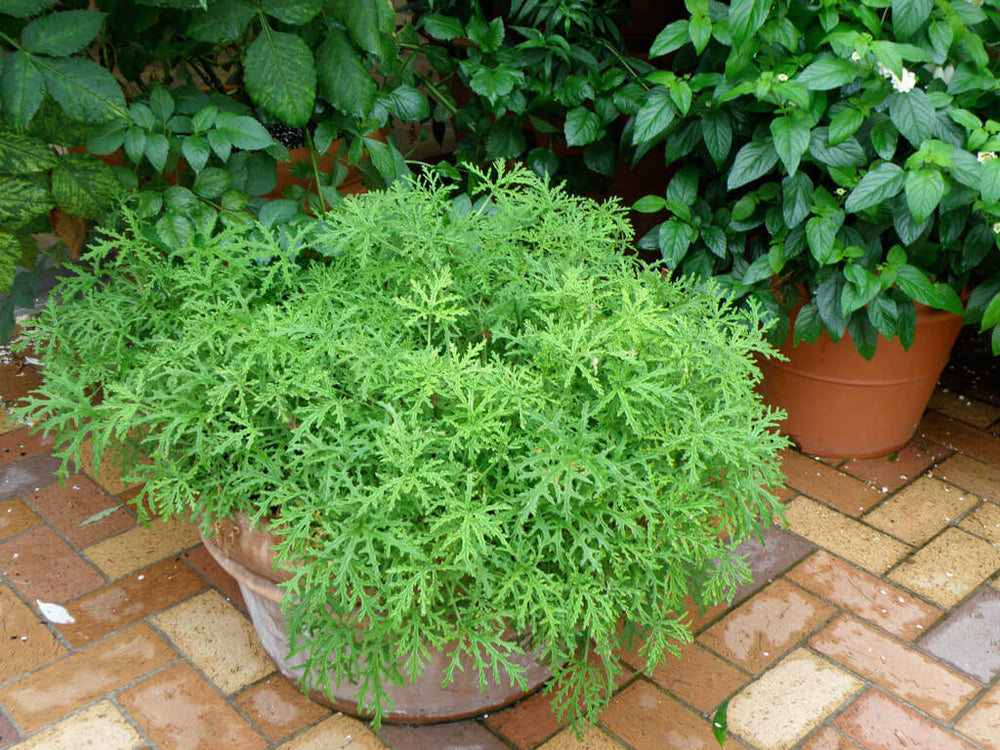A member of the geranium family, citronella carries the fragrance of citrus in its foliage. When leaves are crushed and the oil rubbed on the skin, it smells wonderful and may help naturally discourage mosquitoes. (The plant itself does not act as a deterrent to the pests.) Plants owe their medium green texture to the lacy leaves. Growing upright to 2 to 3 feet in height, they can be used as a summer border or one of several contrasting textures in a garden composition or a large mixed container.
Quick Guide to Growing Citronella
- Plant citronella in spring once all chances of frost have passed and the soil is warm. A good rule of thumb is to plant the same time you plant tomatoes.
- Space citronella 18 to 24 inches apart in an area that receives partial shade and has fertile, well-drained soil.
- Improve your native soil by mixing in several inches of aged compost or other rich organic matter.
- Check soil moisture every few days and water when the top inch becomes dry.
- For abundant blooms, feed regularly with a water-soluble plant food.
- Once mature, prune citronella as necessary and enjoy the fragrant leaves and flowers in summer arrangements.
Soil, Planting, and Care
Plant in spring after the danger of frost has passed and the soil has warmed, about the same time you plant tomatoes. Select a location with a little afternoon shade, and space plants 18 to 24 inches apart. For best results, choose young Bonnie Plants® citronella (also called mosquito plants), which are strong and vigorous.
Though citronella plants are tolerant of a wide range of well-drained soils, moderately rich, moist soil will produce the best growth. Create just that kind of root environment in your garden by mixing 3 inches of aged compost-enriched Miracle-Gro® Performance Organics® All Purpose In-Ground Soil in with the top 6 inches of the existing soil. If you prefer to grow in pots, fill them with lighter, fluffier Miracle-Gro® Performance Organics® All Purpose Container Mix, which is good for both indoor and outdoor growing.
Citronella will grow best with a mix of great soil and premium plant food. Feed regularly with Miracle-Gro® Performance Organics® Edibles Plant Nutrition, which feeds instantly and nourishes the healthy microbes in the soil as well as your plants.
Ideally, you'll want to water whenever the top inch of soil dries out. Good news for gardeners in drought-prone areas, though: Citronella is relatively tolerant of summer stress.
An evergreen perennial in zones 9 to 11, citronella usually grows as an annual where freezing temperatures occur. In addition, the stems can become quite woody by summer's end. If you want to overwinter your plant, propagate a new one during the late summer months by layering. Set a pot filled with potting soil beside your big plant. Bend a stem (still attached to the big plant) gently toward the pot, being careful not to break it. Bury the stem sideways at a point at which a leaf is attached, keeping the growing tip uncovered. Place a rock or piece of brick over the buried stem to hold it in place. After a few weeks, roots will emerge from the stem and grow into the potting soil. At the end of the season (and before frost), cut the stem free from the mother plant and move the new young plant indoors for the winter.


Troubleshooting
You will know if a citronella plant does not have enough light, as it will stretch and fall over. Make a mental note to give it more sun next year, then cut back long, lanky branches to bring it back into shape.
Harvest and Storage
Citronella plants respond well to pruning, so don't be afraid to cut branches for inclusion in summer bouquets, especially if you are dining outdoors. The fragrance will be a welcome addition, blending with more floral scents. In addition, the way the leaves are attached to the stem means that one branch of citronella will help hold other flowers in place in the vase.
FAQs
Are there any culinary uses of mosquito plant, like other scented geraniums?
Yes, you can use mosquito plant with its citrus scent as you would use other scented geraniums, in jellies, teas, fruit salads, and in desserts. One traditional use is to place the leaves in the cake pan before pouring in the batter. Once baked, the cake will carry the flavor throughout.
Do you have suggestions for what to plant with mosquito plant?
The sun-tolerant caladiums and coleus would be excellent paired with mosquito plant. For flowers, consider zinnias, dahlias, shrub roses, hibiscus, vinca, or black-eyed Susans, to name a few. Just be sure to give each one room to mature without crowding the others.
What is the best way to keep my plant alive through the winter?
If you live where the temperature outdoors will not drop below the 20s, cutting plants back and mulching well should get them by, allowing them to sprout and grow in spring. If your winters are more severe, however, lift plants with a fork or spade, cut them back, and plant them in a pot. After a week or two, apply a timed-release fertilizer to the surface of the potting mix. Keep the plant in bright light and water when the soil begins to dry out. Replant in spring, cutting back any thin or weak growth from the winter months indoors.





 Herbs
Herbs
 Vegetables
Vegetables
 Fruit
Fruit
 Flowers
Flowers
 Succulents
Succulents

